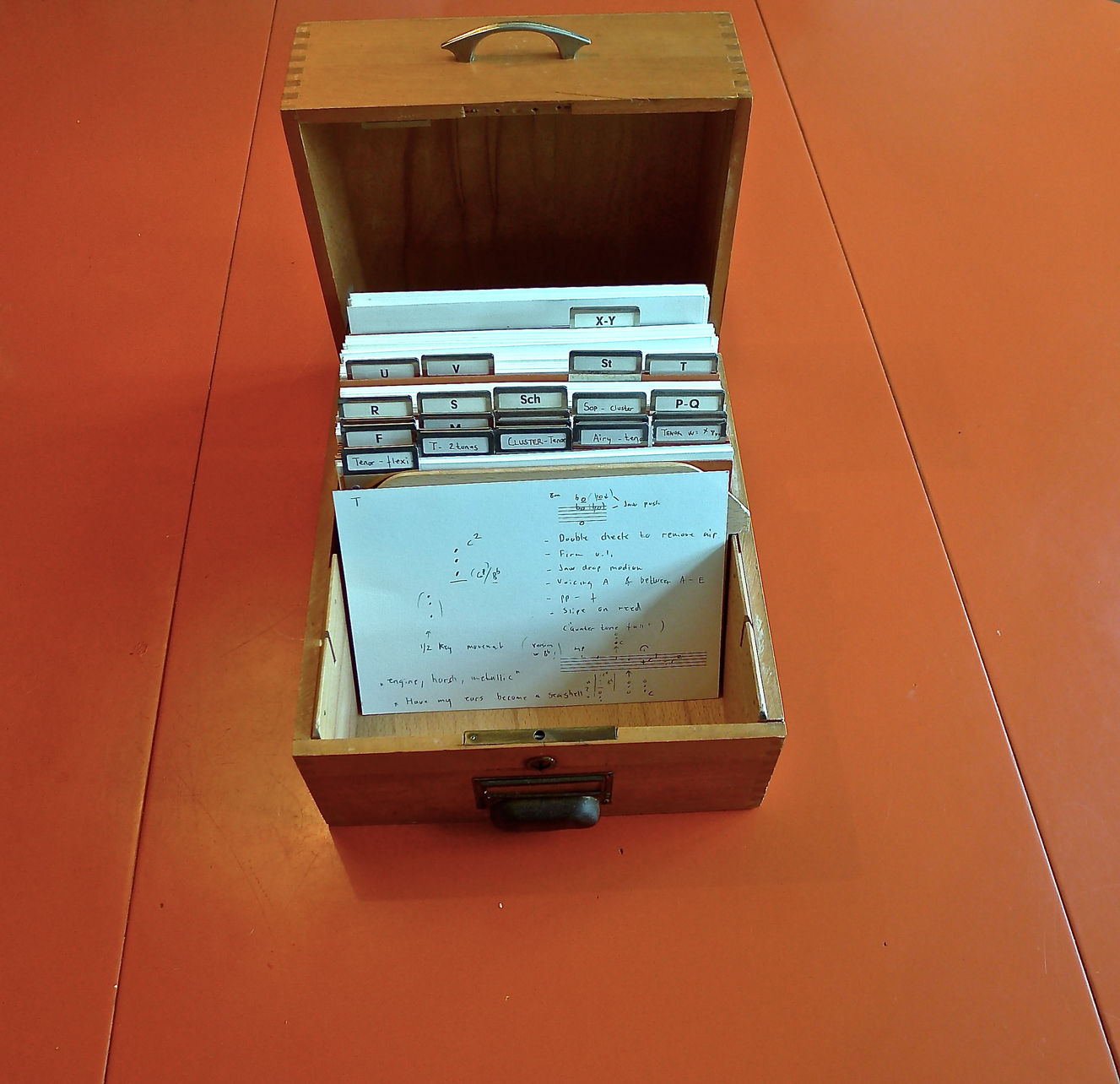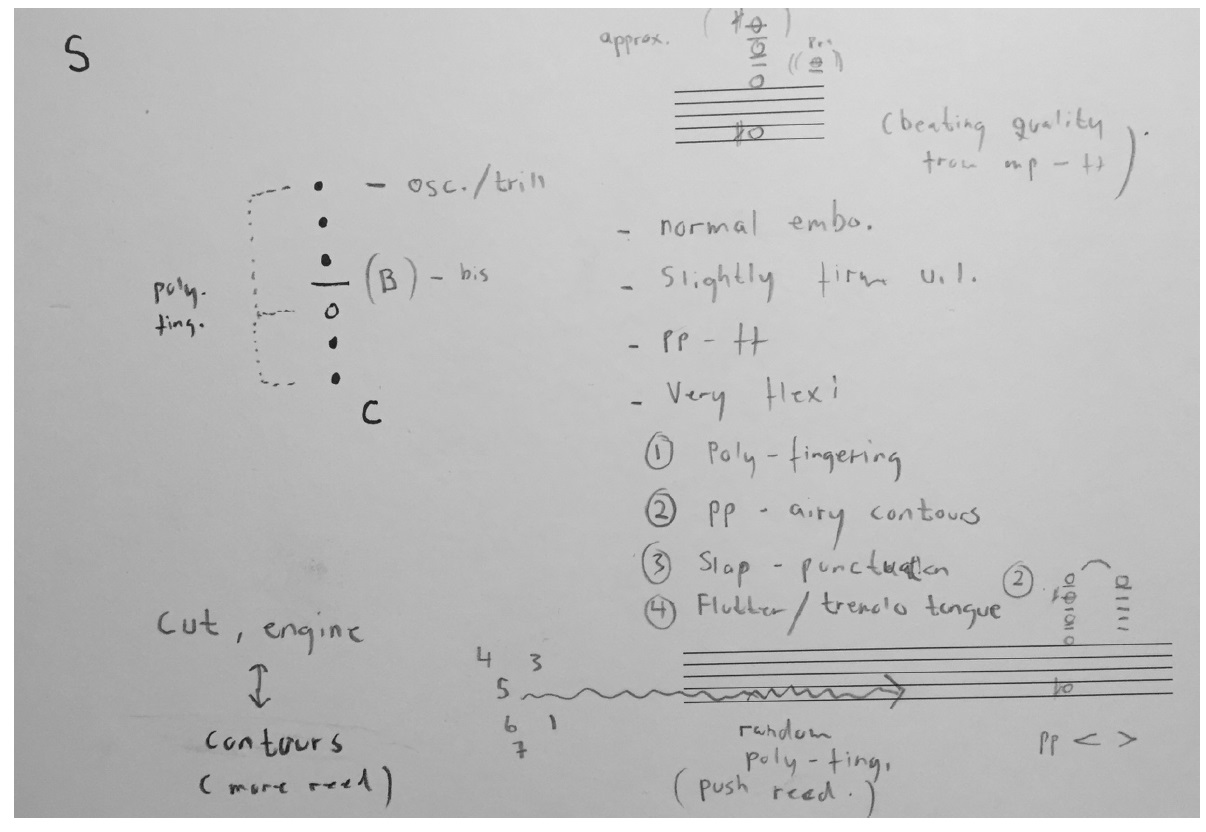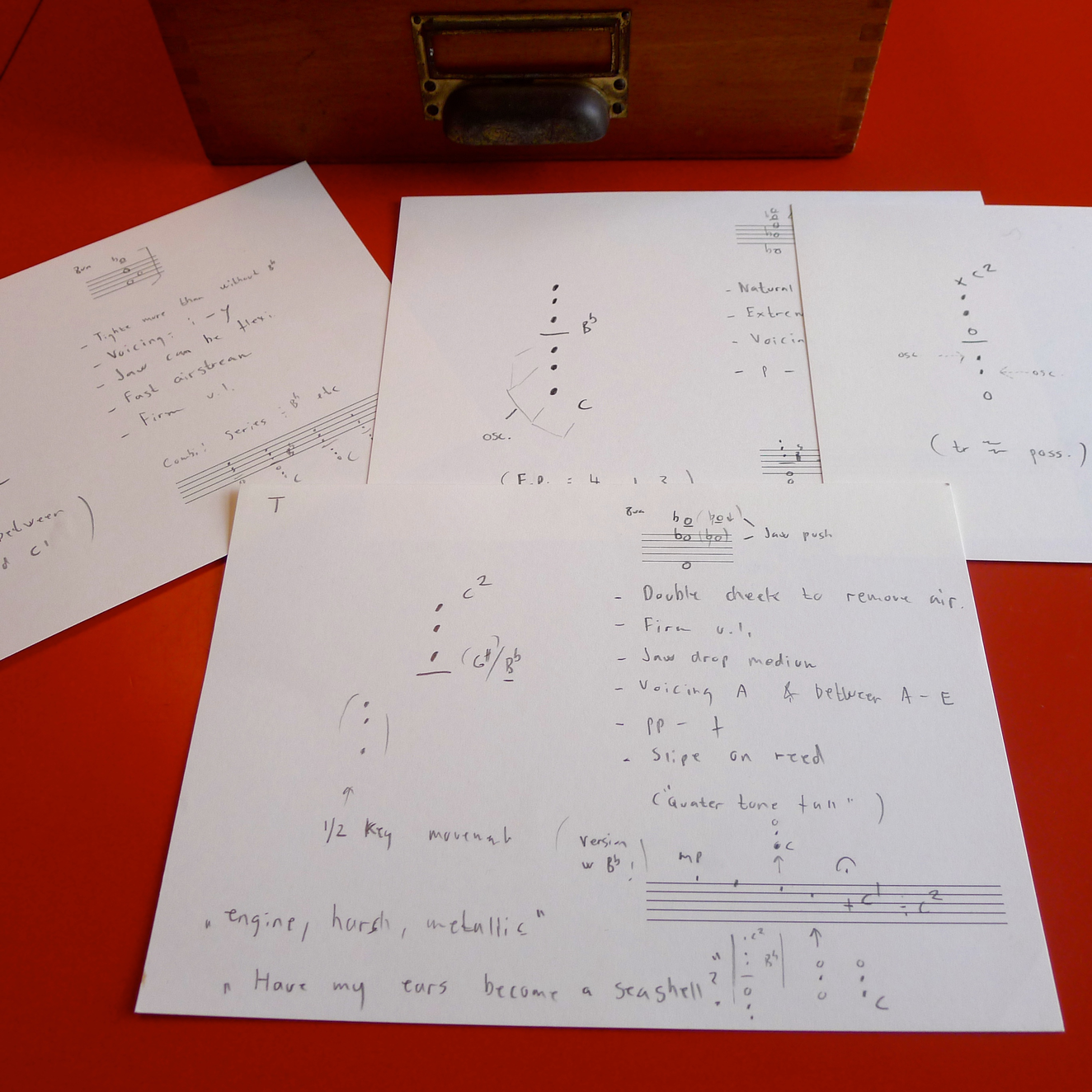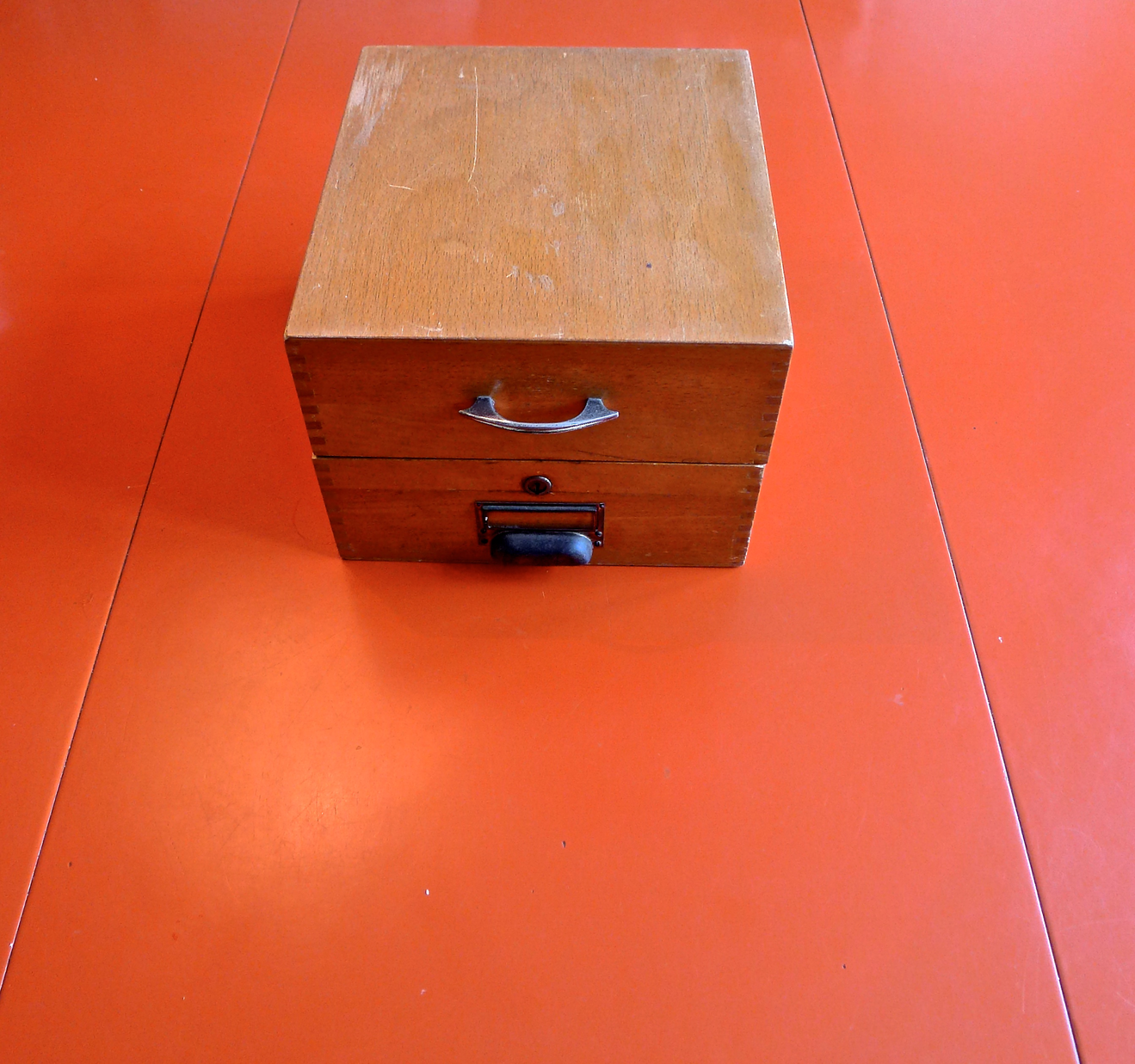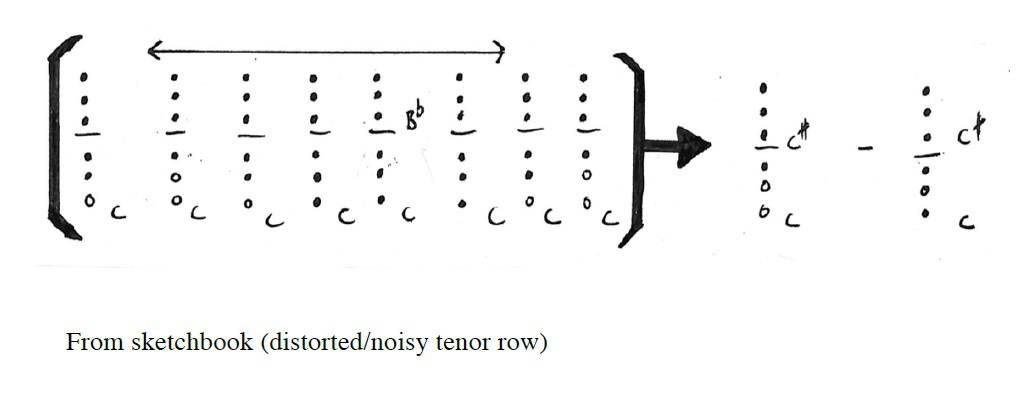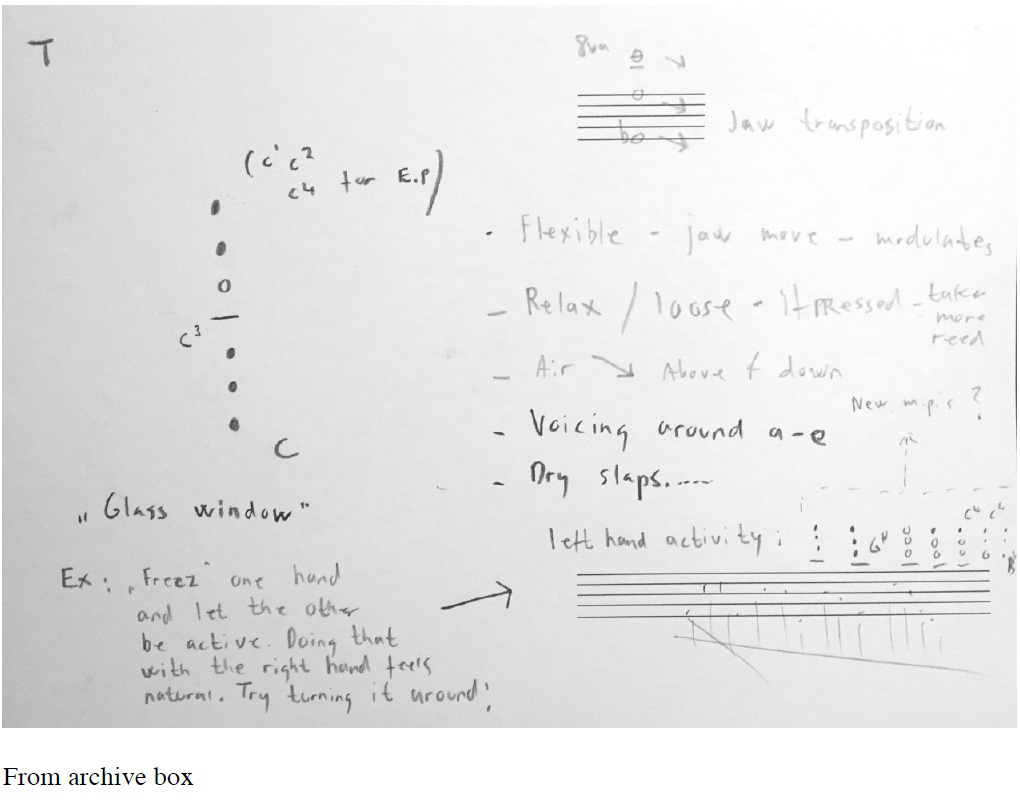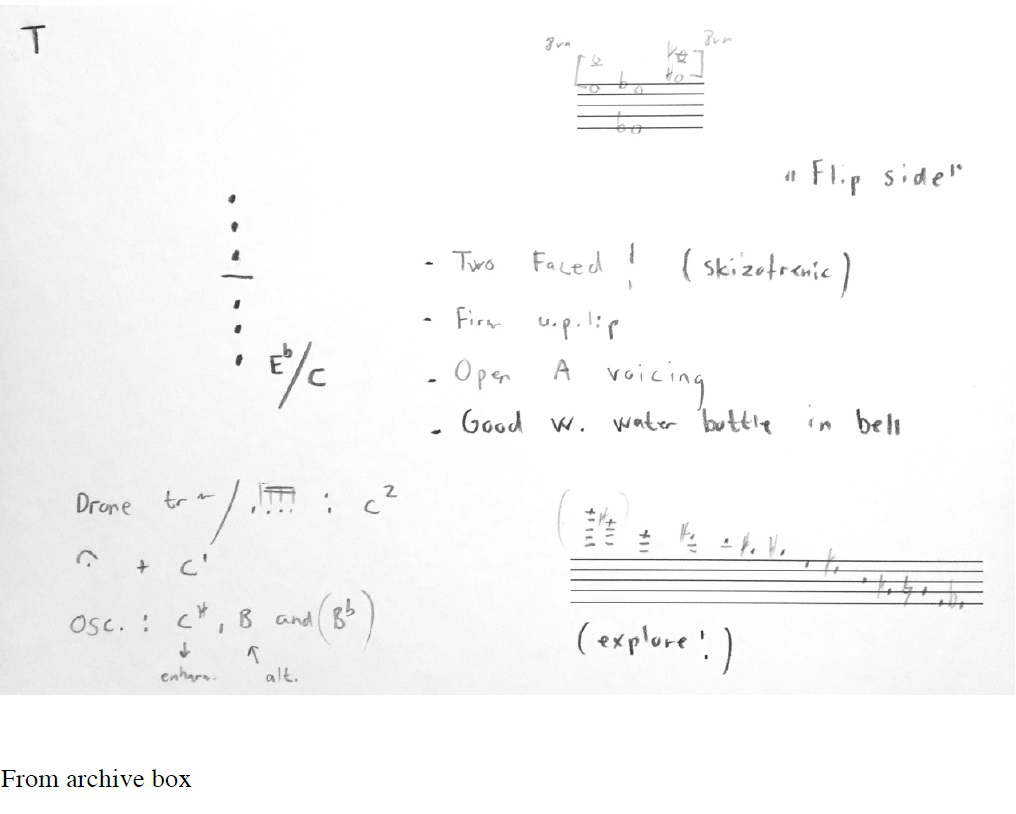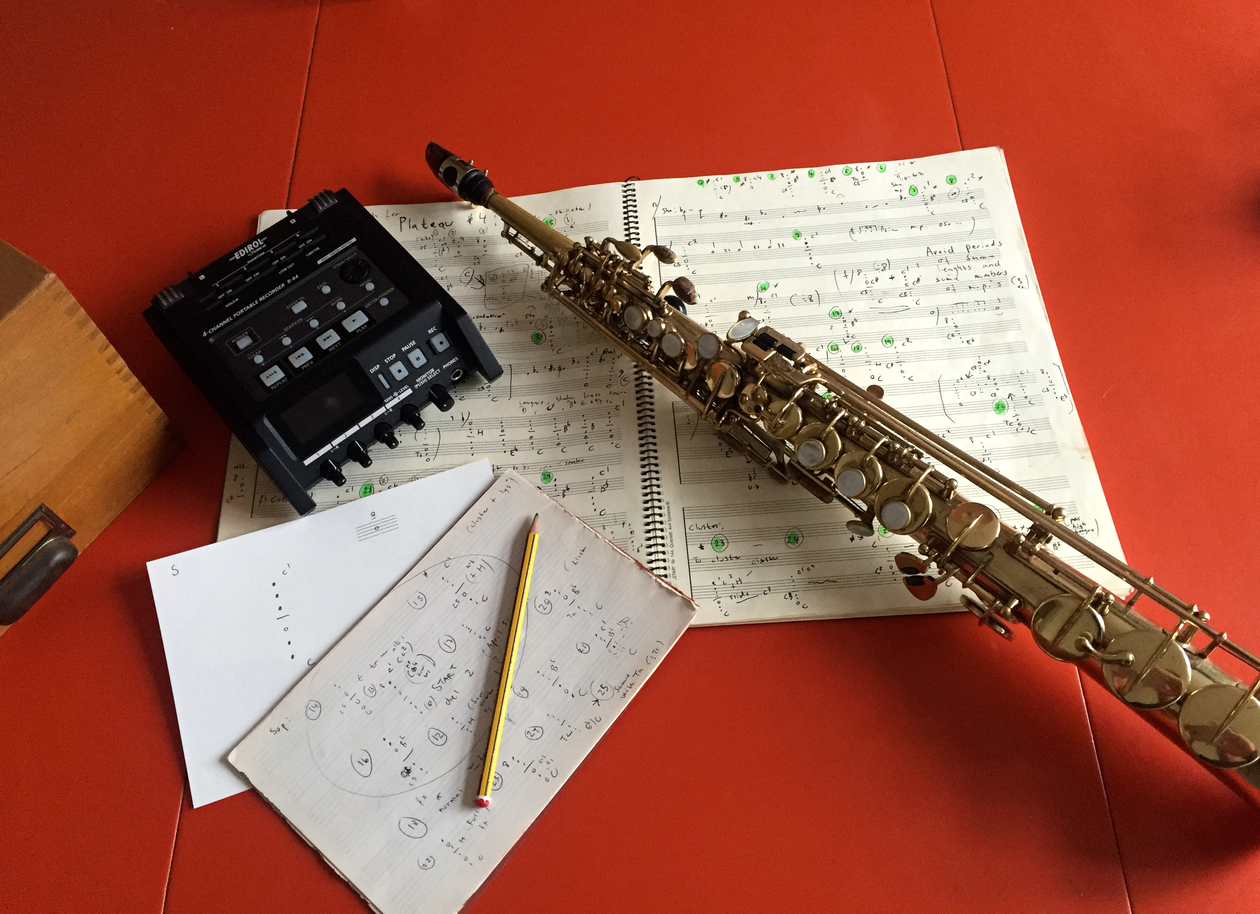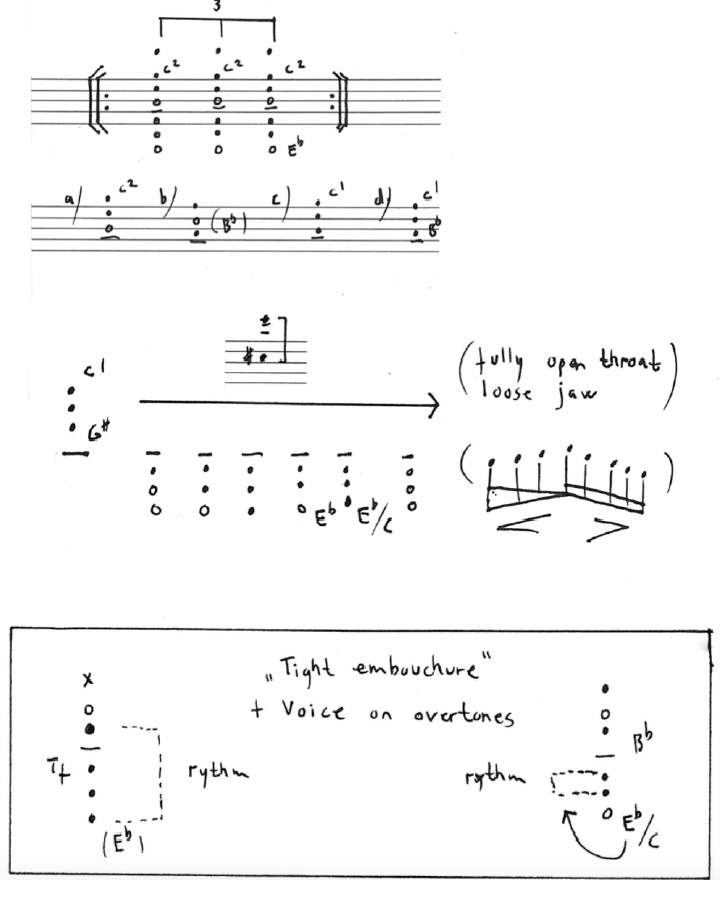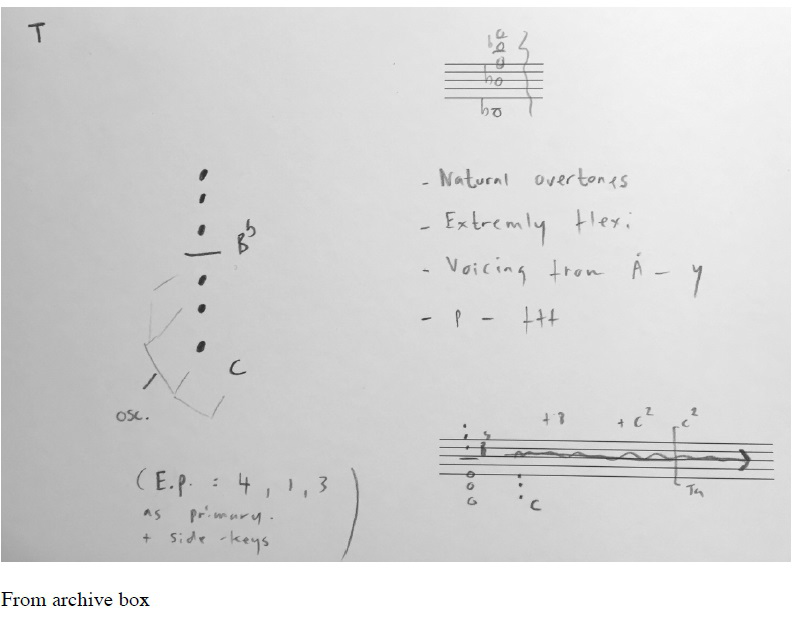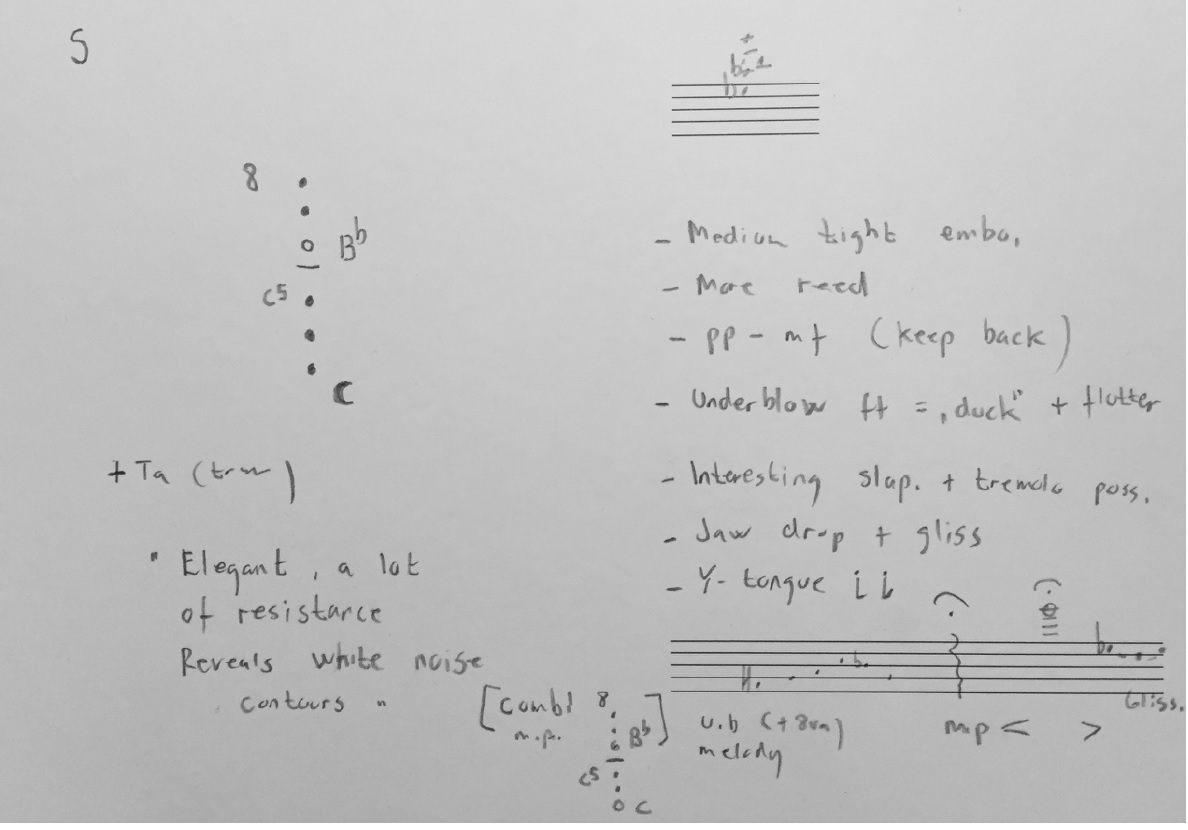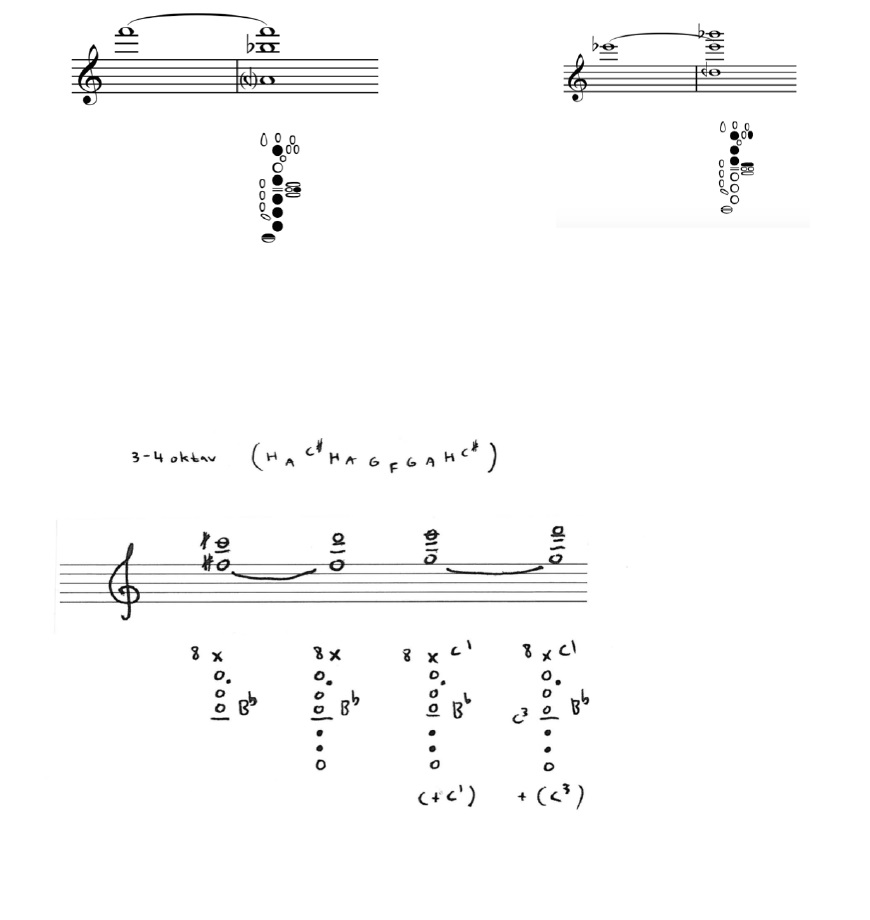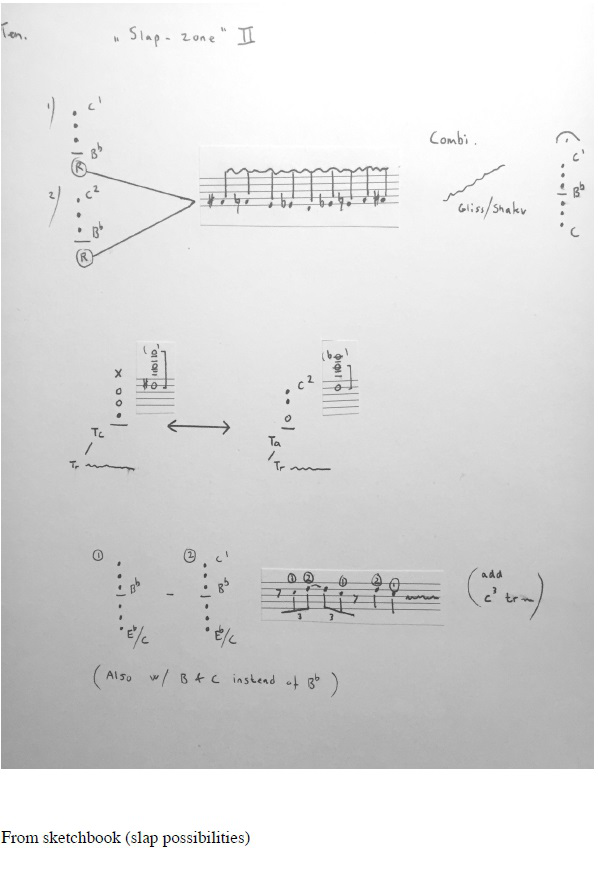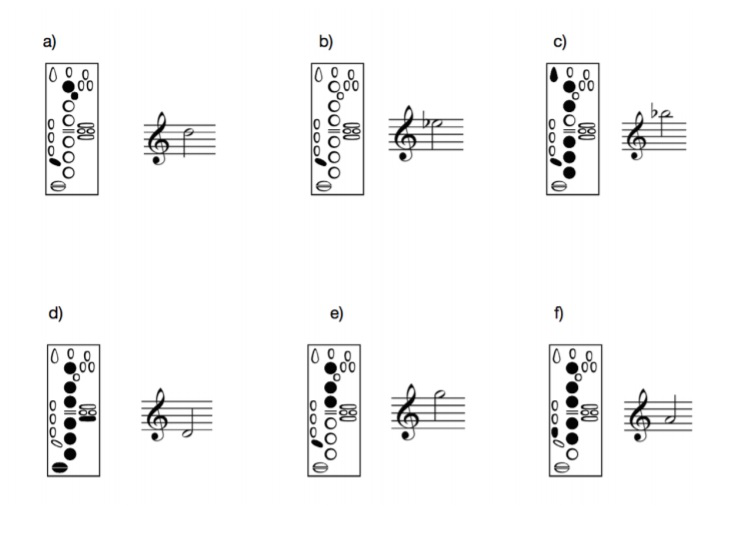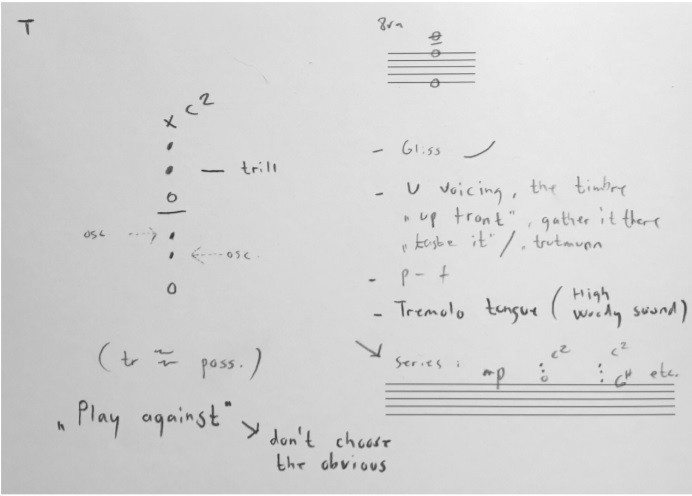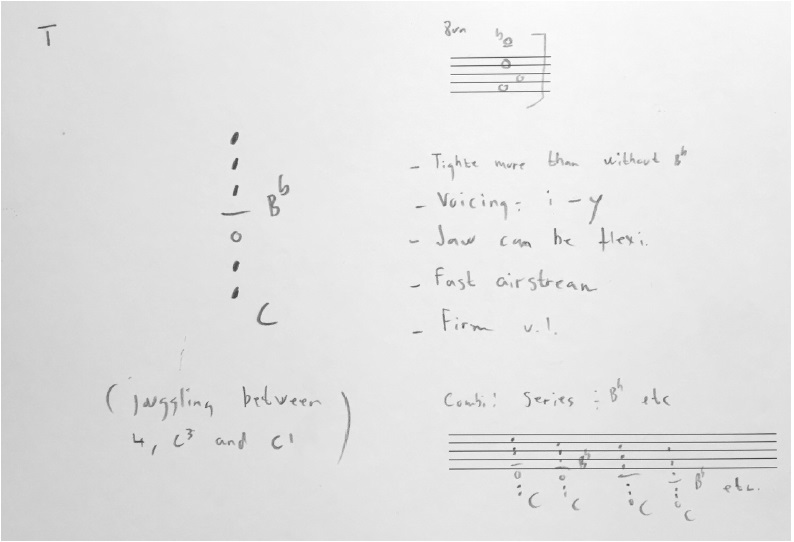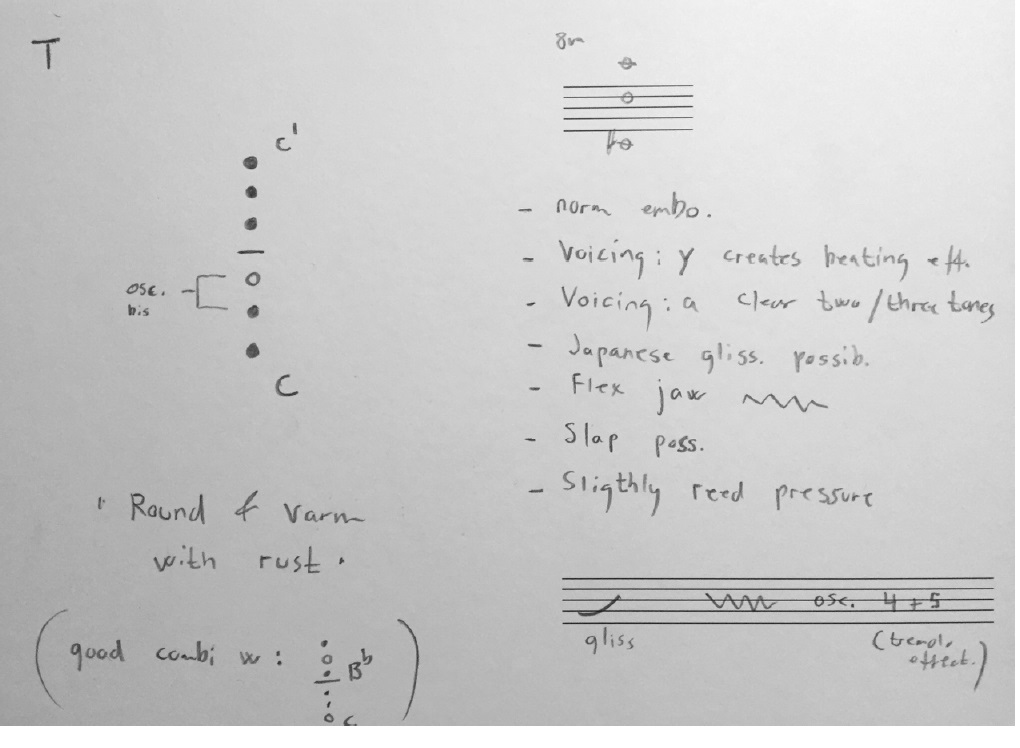Introduction 1. Entering the Landscape 2. Exploring the Territory 3. The Reed Trumpet 4. Influences 5. Solo 6. Trilogy 7. Epilogue 8. Appendix
__________________________________________________________________________________________________________________________________________________________________________________________________________
Here the fingering possibilities are outlined on the left side of the card. As one also can see, there are other usages, such as flutter/tremolo tonguing, slap and punctuation, and also the transparent/airy sonics presented before. Nevertheless, working with this on the poly-rhythm fingering possibilities is what I wanted to show here and I use this technique often. In the piece Stellar Droplets on the Plateau album (around 3:10) I use this particular one applying circular breathing and with multiple tongue and embouchure positions. Another examples of that way of working with the multiphonics one can hear in Periechon from the same album. Particularly from 3:28 and to the end, is a long exploration on these techniques with a vast amount of different ‘home multiphonics’. Note that all these poly-fingerings can of course also be further manipulated by tonguing techniques, vibrato etc.
Here are some other examples of a possible notation of the technique, taken from some of my notebooks. I call it “Polycirkel” here and excuse my Norwegian writings here and there:
2. Exploring the Territory of Multiphonics
“To me, I took a militant attitude towards sounds. I wanted sounds to be a metaphor, that they could be as free as a human being might be free. That was my idea about sound. It still is, that they should breathe ... not to be used for the vested interest of an idea. I feel that music should have no vested interests, that you shouldn’t know how it’s made, that you shouldn’t know if there’s a system, that you shouldn’t know anything about it ... except that it’s some kind of life force that to some degree really changes your life ... if you’re into it.”1 (Morton Feldman)
There are many other examples I could cite and analyse in this way but the final cards and notesbook extracts are with no further comments. They represent just a few more glimpses of the hundreds of possibilities there are. Many of them are to be heard in the recordings done for this project, which I discuss in Chapter 6.
This is an example of a card with a soprano multiphonic. The notation is only meant for me. It is an easy one to achieve, and very flexible. The pitches are approximately, but the two lowest pitches are very exact (with good intonation). There are some notations on embouchure (Firm upper-lip and the voicing possibilities (vowels: a, e og y) With normal embouchure these will create the three first pitches B=a, adding an D=e and to get the C#=y (small letter are the vowels) Furthermore the multiphonic can be very distorted adding the two upper pitches.
Good for precise articulation/punctuation. Osc. is short for oscillation possibilities and shows which keys. There is also information on ff (fortissimo) trill/tremolo. Finally, it says Shakuhachi possibilities. This means isolating one pitch to use it as a monophonic sound (in this case the fundamental/lowest pitch in the multiphonic) My reference here is the wooden breathy quality of the Japanese flute Shakuhachi.
Isolating one pitch in this way creates a vast amount of possibilities for creating sounds with very different textures than with normal fingering. I have mentioned that I regard these as monophonic sounds arrived at by using multiphonic fingerings. I use the technique especially on soprano, since it gives me a very breathy wooden flute sound (if one opens up the throat and lower the tongue as much as possible). It is often flexible for glissando and vibrato.
A sound example of these could be found on the Winds of Mouth6 album, and its title track Winds of Mouth (about 0:47 into the piece).
Here are some of the notated examples more of these soprano sonics:
As one can see from the information I have given myself here, it has many other possibilities of being superimposed by ‘further manipulation’ techniques: Under-blow (very low jaw position) in fortissimo creates a ‘duck’ like sound. A high tongue position (vowel- y) can create high harmonics and be very articulated as well. There are glissando possibilities, slap and tremolo tonguing, and trills. Also a combination multiphonic that is both mechanically easy and harmonically interesting. On the bottom note line, at the beginning, there are small notations on a u.b. melody (under-blow with octave key), playing with octave key on, but push the jaw so low down that it creates pitches approximately an octave down (only in some cases, as it can also be a not equal tempered 7th or 9th down.) When played very soft this also creates a reference to ethnic wooden flute. These small melodies occur many places in the mentioned Sea Meet Shore (5:29 for example) They are often a ‘true’ multiphonic since they tend to have contours of harmonics around them.
Next card portrays an easy and often used (not only by me) multiphonic played with polyrhythmic fingering structures; separating left and right hand. Consequently, creating a quasi polyphonic impression. (Variable speed and with very flexible embouchure, creating a wide frequency spectrum):
Especially the ‘two tones’ multiphonic is used in dense multi-tracked layers in April Flourish on the Winds Of Mouth album (from around 3:20) Here are some of them:
2.2 Step by Step (Factors, parameters and manipulations.)
Let us take a closer look at the different phases of my multiphonic exploration, listed here in three phases. As discussed in detailed in the former chapter, there are many considerations to be taken into account when approaching them, first and foremost the authority of the ear. What we might term as highly individual factors are the following:
A
Body and saxophone equipment :
1) Anatomy (resonant biology of the player; air, lungs, throat, oral cavity, lips, jaw, teeth etc.)
2) Instrument model (material, how parabolic conical is it – new/vintage, key system)
3) Mouthpiece model (material, exterior dimensions, chamber size, tip opening and facing)
4) Reeds (material, brand and strength/thickness)
In my experience the equipment one chooses to use will have considerable effect on how a multiphonic will respond and sound. As well as discussing this with several saxophone colleagues, I have play-tested different saxophone models, reeds, and mouthpieces during my research. Without trying to advocate a general theory here, each of these factors made some multiphonics accessible and others hard to unfold at all. The response, intonation and general ‘feel’ of these set-ups were remarkable divergent. Also, the slightest minuscule modifications on where the mouthpiece is on the neck will change the multiphonics considerably. Having a broad experience in both classical and jazz orientated playing, obviously using various instrument set-ups, I believe I might have a fair amount of flexibility to adjust to their differences. Still, these were obvious in my experimentations.
The instrument set-up I use now is the same as when I started my research. A lot of things can be said about saxophone equipment (and this is not the place for it), but let me just point out that I consider any changes in them as primarily an invitation to new compromises. One never gets entirely satisfied. Instead, a possible confidence in the selected equipment can occur (if it feels flexible enough to function applying a series of different playing techniques and present to you some timbral choices). Thus, replacing former doubts with a strong focus on what you actually can express through it.
B
Next phase will then be to work on the specific parameters of the anatomy – the whole embouchure apparatus so to speak:
Air: the amount, direction, speed and support.
Neck and throat: head position, opening or tightening the throat´s tract.
Vocal tract (or embouchure): In general: tight, normal, relaxed
Tongue: adjusting the oral cavity by tongue positions, usually the back of the tongue (e.g. voicing vocals a, e ,y i, o etc.)
Reed: take more or less of the reed or mouthpiece into the oral cavity
Reed pressure: affecting the the opening between the tip of the reed and the mouthpiece tip rail.
Jaw flexibility: intonation – stability of pitches
Lip: dampening/mute the reed (maximum contact with reed) or let it vibrate freely (minimum contact with reed)
All these elements work together. To be able to precisely ‘hit’ a specific multiphonic one is depended upon a corporeal memory of the positions. The work being done in this phase is at the core of how to achieve control over multiphonics – the fundamental factors of any manipulation of them is constructed here. All these parameters will enable one to monitor and expand the range of the multiple sonics and isolate the pitches being detected as well as to alter the timbre (e.g. dark, mellow, breathy, nasal/thin or harsh/squawky, woody, brassy etc.). It becomes achievable to produce leading notes or a melody line from a multiphonic - from the alteration of the embouchure and precise breath control one can cause a note to sound louder and clearer than the others, making it possible to work with a simultaneous creation of melody and harmony. It will also provide control over the sonic dynamically, from ppp to fff. Accordingly, the tone quality and balance in them will change drastically and propose a palette of textural possibilities.
C
Further Manipulation.
Finally, what we can call further manipulation (or consideration of superimposed/additional manipulation), could include any added playing techniques and instrument preparations in the following list (and possibly more):
Articulations: staccato – tenuto, diaphragm breath instead of tongue, slap tongue (closed or open) , tongue ram, flutter tongue, ‘tremolo tongue’, ‘split tonguing’,double/triple tongue.
Durational stability: shortest = slap, longest = circular breathing.
Trills – regular, double, quarter tone/microtone, half-key trills, tremolo, bisbigliando as oscillator.
Vibrato (lip, tongue or diaphragm) regular, irregular, intensity, tempi.
Key- intonation of pitches – (slow, fast, big, small).
Glissando and portamento (with lip or with fingering).
Voice – singing simultaneously. Normal voice, humming, falsetto, distorted voice, growl.
Air/breath sounds (with minimal clear pitches – breathy white noise-like) Key clicks and and other percussive effects.
Teeth on reed.
Instrument preparation: e.g. mutes (knee, silver paper, water bottle, textiles, lengthen the bell etc.) or tone hole and/or mouthpiece manipulations with sticks, wax, paper).
All of these techniques will affect the ‘home’ multiphonic fingering and they will respond very variable to them. (On some (e.g. teeth on reed), the sonic result will be very far from the natural sound of the home’ multiphonic fingering). The outcome of this exploration will give strong indications on the sounds intrinsic quality and the possible plasticity in them. Needless to say, these can be juxtaposed, varied and morphed with endless possibilities of conventional and unconventional technique as well. In both these phases, I believe the multiphonics’ intrinsic quality seriously starts to create a dialogue with one’s artistic intentions.
2.3 Method – different levels of manipulation
Out of this comes a specific method of exploration that could be applied more or less chronologically. In this process there is a constant shifting between listening to the instrinsic quality and one owns artistic intentions.
1.The ‘home’ multiphonic (or ‘natural’ multiphonic) of a given multiphonic fingering: This will produce one particular multiphonic, so much easier than anything else, that you could call it the home multiphonic of that given tablature. In this phase it is about getting these possible pitches to vibrate, to investigate what’s there.
2. First level of manipulation:
a) Isolate different regions:
Next phase is about suppressing, let’s say the lowest frequencies or the higher frequencies, and select a specific frequency or frequencies inside the multiphonic that cannot naturally be reached at that level without further vocal tract manipulation.
b) Gateway multiphonics:
Not all fingering will have a sense of clear, easiest speaking spectrum, but some do. They are stable and reliable (can be used for punctuation really). The stable ones could act as gateways to the less stable ones – a potential for the stable ones to mutate into less stable ones. (Note here that they are sometimes only less stable because one’s ears do not know what to listen for or that the reed does not respond the way one want it to.)
3. The secondary level of manipulation.
a) Further Manipulation – consideration of superimposed/additional manipulation: To apply all possible playing techniques on the home multiphonic, consequently changing the multiphonic’s character and function. In some cases only creating a vague reference to the original home multiphonic as well as drifting away from it towards other multiphonics.
b) Juxtaposition and morphology: The home multiphonic (or its further manipulation) is juxtaposed with any other sounds (conventional or unconventional). Also exploring the multiphonics through a transgressing morphology ‘that allows one to gather together sounds with similar forms or functions in chronological or geographical sequence so that variations or evolutionary changes might become clear’, as R. Murray Schafer writes4. Thus turning one sound into another. Through mutation and variation procedures all of the mentioned manipulations then starts to create larger and larger events of musical gestures.
2.4 Classification?
Any classification can give information to help discover connections, significant patterns, contrast or similarities. However, I have discovered that many of the multiphonics overlap into different classification categories depending on the effect the different levels of manipulation have on them. Although I have not classified my multiphonics systematically, I could at times group them for instance according to the aesthetic quality or pitch content. I might then use these in improvisations or composition that yields for a certain coherence in the material, that could be, let’s say a group of breathy/transparent sonics. Another example might be a group of multiphonics where the range and pitch content could be classified and used harmonically or melodically. If not directly classifying the multiphonics, my notations might include:
a) Tonal spectrums: pitch content and range i.e. similarities between multiphonics depending on whether the multiphonic is an unstable dyad (a set of two notes or pitches) or a more stable spread of notes, which typically involves the interval of a minor ninth or minor twelfth.
b) Mechanical consideration. Groups of multiphonics that can easily and at faster tempi be combined, with neighboring fingerings (close to each other).
c) Combinations groups: combinations of multiphonics regarding “harmonic”, melodic or aesthetic connections and/or the technical simplicity in executing them. Flexibility of combinations (isolating possibilities and combination with other monophonic and multiphonic sounds).
d) Dynamic spectrum: volume parameters and how the timbre and pitch content chances through these.
e) Perceptual level: e.g. harmonies, transients, noise.
f) The aesthetic typology of multiphonic sub-groups. (associations.) harsh, metallic, crispy, smooth, transparent, breathy, distorted etc..
g) Semiotic – The multiphonic used as a metaphor. Notions on purpose and meaning. (One thing is all the possible sonics one can reach for, another thing is for what existential purpose is it used in the music).
Correspondingly, some of these methods and considerations are documented in sketchbooks/notebooks and in the end found their way into what I call my ‘personal library of multiphonic findings’, manifested in a wooden archive box:
2.5 The Archive Box
The breathy/airy and transparent sounds are something that appeal to my aesthetics. There are many multiphonics, both for soprano and tenor that can offer this. The next card is a soprano multiphonic that has this quality and produce a compelling harmonic. It often occurs in Sea Meet Shore on the Plateau7 album (for the first time at 0:50)
Isolating one of the pitches and reach for the second or third pitch (and going back and forth between these), makes it possible to link melody and harmony together.
In the Sulphur Harmonics piece on the Plateau album I wanted to exclusively work on that idea. Only the clean multiphonic without any applied effects. As the title of the piece might suggest, these ‘chord’ are not totally in equal tempered tuning always, furthermore if one aim for only two pitches to sound, often contours of other harmonics occur. Nevertheless, there are many melodic and harmonic possibilities here. As a working sketch for that piece I wrote a circle with some prospects:
Introduction 1. Entering the Landscape 2. Exploring the Territory 3. The Reed Trumpet 4. Influences 5. Solo 6. Trilogy 7. Epilogue 8. Appendix
__________________________________________________________________________________________________________________________________________________________________________________________________________
The saxophone family consists of seven types of saxophones (excluding a few rare ones, such as the modern Tubax, Soprillo, and the much older C-melody). In my project I have chosen to make use of two of these saxophones types: Soprano saxophone and Tenor Saxophone (both in Bb). Also, a third instrument found its way into the research; a hybrid instrument called ‘reed trumpet’. The reasons for including this instrument is manifold, which I will elaborate on later in the chapter; “The Reed Trumpet - a gratifying obstruction”. Here I will, in detail, disclose how I have explored the saxophone multiphonics only.
2.1 The philosophy behind
To be able to hear the pitch content in the seemingly noisy sonorities of multiphonics is something that slowly becomes possible through disciplined practice and experience. When one first encounter them, these ‘noisy turmoils’ can be very confusing to the ear. Continuously working with them, the ear knows what to listen for, and consequently the whole embouchure knows how to adjust according to that. Players that understand the overtone framework of the instrument and have cultivated the ear can discover a vast amount of multiphonics on their own. Going back and forth between solo performance, ensemble activity and solitary practice in the studio, has given me lots of material to work and reflect on. Furthermore, listening to and study a vast amount of music – within the saxophone territory or far away from it, creates an understanding of their possible use within a musical context. Still, the solitary work with the instrument and a very detailed focus on the sonic’s intrinsic quality has been my primary method. This is also what I believe to be of predominant importance when one tries to unfold the saxophone multiphonics and to get a piece of solo music underway. To rehearse, repeat, memorize and modify multiphonics is a crucial part of being able to use these sonic vibrations in improvisations. Working with this complex material, returning to it as a sonic refrain, gives me an experience that deepens each time by new impressions and new physical know-how.
Over an extended period, I have ‘hunted’ and collected a vast amount of multiphonics for soprano and tenor saxophone. With over three hundred multiphonics for tenor saxophone and a little less for soprano, it’s a lot of different fingering combinations and delicate embouchure adjustment that needs to be learned before the material turns into embodied knowledge. Hence using these complex sounds means maneuvering on a knife-edge between aestheticism, auditory awareness and physical boundaries – challenging and rewarding with the potential of producing ever-new layers of complex and intriguing textures.
The multiphonics are primarily discovered during solo improvisation, exploration and experimentation. Many of the multiphonics I try to reach for provokes the instrument’s resistance. In return, unfamiliar sounds are extracted from it. For my own sake, I immediately write down my multiphonic findings along the way and also apply them into a possible musical situation (arguably to varying degrees of success). Nevertheless, it helps me to memorize them better and draw associative (metaphorical) inspiration from them. Later they are worked on for further control and also combined with other sonic findings. Either they get stabilized and incorporated in my playing, or they are passed over for the moment, to be further investigated and unpacked later. The task is then to fine tune them, adding all playing techniques imaginable, and finally listening to the depth of details to be found. Slowly even the most complex multiphonics begin to reveal within. In this way, I try to explore the methodology in the construction of each sound – always with an auditory awareness of the poetics. My intuition and my ear is the authoritative guide here and to a lesser degree do I try to understand the intellectual construction of them – theoretically or mechanically. Since playing solo is also the performative format of my project, this idiosyncratic working method seems particularly suitable.
Intrinsic qualities of the sonic
The study described above, functions as much as a disclosure for compositional and improvisational ideas as an exercise in technical control over the instrument and its possible expressive augmentation. In this process, I don’t necessarily try to force the sounds to fit into a particular musical concept, idea or style.“Not to be used for the vested interest of an idea”, as Feldman puts it. Instead I try my best to be attentive to what the sounds possibly want to tell me themselves – what musical directions they inherently might suggest and seduce me into. In other words, the question becomes: What are the intrinsic qualities of that particular multiphonic? This then is how they pollinate my imagination and sometimes immediately put forward musical meaning. At a slow pace (I must admit), this awareness and cultivation, in the end, opens up for complete musical landscapes.
Imagining a sonic
Without forgetting the intrinsic worth of the sounds, I also tend to search for the conceivable plasticity in any given multiphonic fingering. It’s essential for me, particularly as an improviser, to also be able to sculpt these multiple sounds freely so that they can get as close to my inner sonic visions as possible (wherever these might come from in the first place). Furthermore, to be able to use them in various contexts So, in some cases, I reach out for some imagined sonics for a specific artistic purpose.
Due to the resistance and complexity of the multiphonic technique, ‘the saxophone’s will’ (as described above) and my ‘musical intentions’ creates an oscillating dialogue. In that sense, the scene before us is a constant balancing act between forces of control and non-control – chaos and order. Gravitated towards order, as I believe we all are, it then becomes a matter of trying to stabilizing the artistic outcome of these dialoguing processes. Actively using them in a performance one risks complete failure. Yet, the slightest or biggest coincidence ignites a spark that one hopes will lead to something meaningful. At best, it makes it possible to achieve an intimate and interacting flow in the solo performance that might not be achievable otherwise. An energy is created from the tension field of two forces (man– instrument) that I believe positively informs my music’s gestures, textures, and shapes. Hence, a total demand over the instrument technique in question is not the pursuit for me as an improvising musician; a deep expedition into its prospects and an embracement of a rewarding instability is.
Poetics (from Greek poïetic2)
Before we look closer into the details of my sonic exploration, allow me to elaborate on a word I have used often so far in the text and that is central to my project’s title and understanding. Poetics seems to be used and understood in many different ways. From the literary discourse, literary theory, to something align with rhetoric and also in the meaning of the aestetic position of an artist. ‘The term ‘poetics’ derives from the Greek po(i)tikos (‘relating to poets’) via poisis (making poetry), poiein (to create) and the Latin poeticus. Among the ancients it was used for tracts that dealt principally with the craft of writing’3 In this project I use it in a double meaning, both as the ‘theoretical framework’ that lays behind a poetic moment to happen, and in the meaning of this poetic sensation itself. All the crafts and bolts that leads to something that potentially makes room for an imaginary. I understand poetics in the latter meaning as when something (i.e. music, art, and beyond) has an expressive quality that resonates strongly within me. A poetic moment can often be experienced when this something has a connection with a certain preferred aesthetic quality, but can also occur in every perceived expression possible and in the most surprising contexts. It is, anyhow, quite hard to articulate in words what a ‘poetic sensation’ is. Yet one could at least say that it has the power of changing how humans experience the world – one is touched by the beauty and magic. After going through my notebooks in the process of writing this text, I found a Cage-inspired mesostic that I wrote early on in the project:
The next two cards are also tenor multiphonics, and among other possibilities, they can be used for moving back and forth between one pitch, two pitches and more:
These then, are my multiphonic findings. The file cards contain the fingering charts that work for me – always with an auditory awareness for the poetics. Tabulated in a set of archive cards - a card for each fingering. The notation and information to be found here are only meant to be understood by me and act as a reference in order to be able to reproduce a specific multiphonic I have come across in a rehearsal or performance. This information can be both descriptive and prescriptive. The idea here is to write things down when I find them. Either they get stabilized and incorporated, or they are passed over for the moment, to be further investigated and unpacked later. Thus, I can open the box, pick a card, and wonder: What was that about? What kind of embouchure will unfold this one? Can I add some more information on this one The box acts as something between a notebook and a set of etudes. Made to make sense to me, not to anybody else, it could include anything from subjective notions on physical characteristics (acoustics), how they might be perceived (psychoacoustics), their function and meaning (semiotics and semantics), or their emotional/affective qualities (aesthetics). Practically this usually implies: a) approximately possible pitches of a given fingering b) personal information regarding embouchure c) further manipulation possibilities d) small sketch of possible notation or a little musical gestural idea e) combination possibilities with other multiphonics (cross-referencing) f) symbolic, metaphorical or aesthetic associations/classification (see paragraph 2.4).
I have actually come to regard the archive box as an art object on its own terms. It represents a deep part of my artistic practice and explicitly is:
1) a collection of working notes (a practice diary).
2) a place for generating inspiration.
3) a location for a personally inscribed practice.
4) private, at the moment (closed).
In his essay Becoming-Music: The Rhizomatic Moment of Improvisation (2002)5 , Jeremy Gilbert investigates a possible Deleuzian music philosophy in improvised music. Discussing the indian raga, Gilbert writes:
“The raga cannot even be played and rehearsed in the manner of Western scale or mode: it exists only virtually, on the point of becoming-music, on the very brink between ordered territoriality and becoming-cosmic. Deleuze and Guattari write that a ‘musician requires a first type of refrain, a territorial or assemblage refrain, in order to transform it from within, deterritorialized, producing a refrain of the second type as the final end of music: the cosmic refrain of sound machine (Deleuze and Guattari 1987:349)”
I have referred to my archive box as a personal library of multiphonics, however the reality of these sonics is what actually happens in a performance. Perhaps a sonic material that only exists in the very embodied improvisation . After all, notations of these sounds will never be anything else than two-dimensional symbols of a threedimensional phenomenon. My written documentations of them, function as a ‘springboard’ to my saxophone improvisations and compositions, therefore only represent a robust potential of becoming-music. For this reason, I will turn the attention towards a few extracts, both from the archive box and from different sketchbooks, allowing us to get a ‘two-dimensional’ look into what kind of sonics I have been working with. I will furthermore, in some cases, refer to the ‘three-dimensional’ music recorded during the project. I have added some comments along the way, to give an insight into some multiphonic possibilities and not meant to be a thorough pedagogical or analytical tool. Hence, it is constructed rather freely, but will give a slight glimpse into some areas of my exploration.
2.6 Excerpts – from archive box, sketchbooks and recordings.
(note that the pitches are not written in ‘concert pitch’)
Next card from the archive box is a tenor multiphonic used in the very beginning of the Plateau#3 piece on the Plateau album.
This is an example of a very round and open sounding tenor multiphonic. There are, as always many possible expressions to reach for, but I tend to use it for its Japanese ‘vibe’ (again). It’s very flexible for glissando and vibrato. A clear pitch definition, with the possibility of adding some dissonant to it (the upper pitch). It is also flexible regarding the timbral quality; from round to nasal.
Furthermore, this also demonstrates a multiphonic that I tend to use with spatial focus – slow textural variation using different pressure on reed, tongue positions, attacks and oscillating keys (enharmonic trills etc.) Particularly, the latter is at stake in the aforementioned Plateau#3 (on several multiphonis). This oscillation with the keys creates a slightly altering of the sounds timbre, an enharmonic trill (or other neighbouring pitches).
_______________________________________________________________________
a spiritual Practice
in-between and amOng
deep breathing, carEful observation, interaction
The opening and holding space
speakIng about what one finds there
soniC sensibility
a bridge open in the preSent between the past and the future
4Richard Murray Schafer, The soundscape, our sonic environment and the tuning of the world (Rochester: Destiny Books, 1994) p162
1Morton Feldman, Conversation between Morton Feldman and Walter Zimmermann
http://www.cnvill.net/mfzimmr.htm [accessed 2015, November]
2Poietic (and aesthesic) are terms used in semiotics to describe perceptive and productive levels, processes, and analyses of symbolic forms. https://en.wikipedia.org/wiki/Esthesic_and_poietic [accessed January 2016]
3“Poetics of Music”, King’s College London, the Britten Estate Ltd., the Institute of Advanced Musical Studies (KCL) http://www.kcl.ac.uk/artshums/depts/music/research/proj/poetics/index.aspx [accessed 2016, Januar]
